soziale stadt - bundestransferstelle
besonderem Entwicklungsbedarf - Soziale Stadt"
Flensburg Neustadt |
|||||||||||||||||||||||||||||||||||||||||||||||||||||||||||||||||||||||
|
Matthias Frinken In 1999 the model area "Social Urban Renewal Flensburg-Neustadt" was included in two urban development programmes, the "classical" Federal-Länder urban renewal programme and the new "Socially Integrative City" programme. It covers the 51 hectare "Neustadt" urban renewal area, officially designated at the beginning of 2000, and the approximately twice as large surrounding framework plan area. Only in the urban renewal area is the whole range of classical investment measures being realised, like modernisation and repair, road construction, and regulatory measures. In the framework plan area measures are given support only where they are in keeping with the "Socially Integrative City" approach and which are closely interwoven with circumstances of life in the action area (public facilities, pathway network, neighbourhood improvement). 1. Nature of the area
|
|||||||||||||||||||||||||||||||||||||||||||||||||||||||||||||||||||||||
 |
| (Source: Flensburg Municipality) |
The centre of the officially designated urban renewal area is occupied by approximately 6 hectares of derelict land, the site of a former timber business, vacant since the 1970s, and the abattoir demolished in 1993. More than 10% of dwellings in the action area, to some extent in dire need of modernisation, are vacant. The framework plan area also includes industrially used land on the shores of the fjord, the future of which currently appears to be ensured, and other industrial land to the east and areas to the west characterised by residential and communal uses.
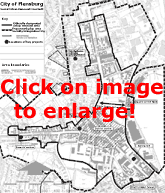 |
(Source: plankontor GmbH, Hamburg) |
A total of about 4,500 people live in the renewal area; a higher than average proportion belong to disadvantaged population groups. There are two or three times as many unemployed people, social assistance recipients, migrants, single-parent families, and young people with no secondary school qualifications as in the city as a whole.
2. Main Problems and Development Potential 
Neustadt shows enormous complexity in overlapping and interdependent social, economic, and urban development problems attributable to general societal trends and economic structural change in the region. Neustadt is affected by both citywide and small-scale, local problems. The negative image of the district that has developed over years, persistent social segregation and a lack of private sector investment are the consequence. Besides the negative image of the district, the main problems to be mentioned are the following.
Structural/urban development problems: large-scale functional mix with mutually problematic uses, (industrial) derelict land, a large number of underused lots and buildings, a high residential vacancy rate, high building density and surface sealing, extensive modernisation and repair requirements, deficient dwelling environment, strong environmental nuisances from polluting industry and traffic on major thoroughfares, inadequate pathway and cycleway networks, a lack of public green and open spaces and of playgrounds.
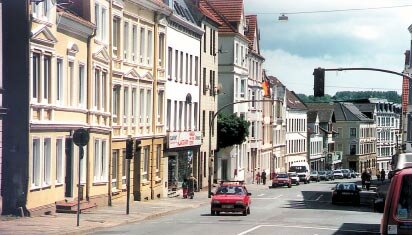 |
Vacant buildings are concentrated along Harrisleer Straße; they are to be remodelled in the course of rehabilitation (Source: Stefanie Hagen, Flensburg Municipality) |
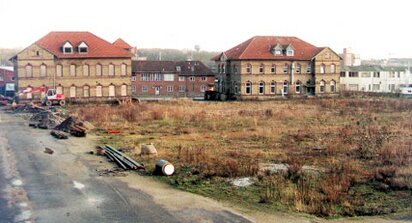 |
The site of the former abattoir is suitable for green finger connections, playgrounds and sports areas and for new industrial developments (Source: plankontor GmbH, Hamburg) |
Social problems: unbalanced social structure, segregation to the detriment of Neustadt, below-average household incomes, above-average dependence on transfer payments, low levels of education and training, social tensions, a lack of youth facilities and opportunities for non-commercial socializing, inadequate public and counselling facilities, as well as a lack of health care and insufficient provident behaviour.
Nevertheless, Neustadt offers wide-ranging potential for development to reverse the negative trend. For example, the current small-scale use structure and the highly diverse, multicultural population mix must be seen as opportunities and points of departure for the district to develop a very special character of its own. Another important resource is proximity to the fjord with the physiographic situation of the slope location towards the water. Derelict land and vacant buildings offer numerous spatial and functional design and conversion possibilities. Thus deficiencies, for example in public open spaces, could at the same time be eliminated and possibilities gained for coping with economic structural change. Moreover, the establishment of a district centre is possible to provided a place to meet, a cultural venue, and service amenities. Modernisation and measures to improve the dwelling environs can enhance the quality of life and personal well-being in the area.
Demography and Social Space
|
Neustadt (1) |
Flensburg |
|
|
Size |
51 ha (urban renewal area) |
5 644 ha |
|
Population (1998) |
4 532 |
85 547 |
|
Population decline (1994–1999) |
13.8% |
4.4% |
|
Average household size (1998) |
n.a. |
n.a. |
|
Number of dwellings |
2 490 (1998) |
43 296 (1987) |
|
Vacant dwelling units (1998) |
265 WE |
n.a. |
|
Housing benefit recipients (1998) |
7.0% |
3.9% |
|
Unemployment rate (1998) |
30.0% |
16.4% |
|
Social assistance recipients (1998) |
22.0% |
9.0% |
|
Foreign population (1998) |
24.1% |
8.6% |
|
Population under 18 (1998) |
20.7% |
17.9% |
|
Population 60 and older (1998) |
14.0% |
13.2% |
|
(1) The data for Neustadt are based on preparatory studies carried out in 1999 and refer largely only to the urban renewal area. More recent and more detailed data for the entire model area are not currently available. |
||
At the same time, Neustadt offers space and opportunities for accommodating and integrating new population groups who would like to work or live in the district and contribute to the development process. This special Neustadt mix can generate a positive image for the district.
3. Development Goals and Focal Points of Action 
The development goals for Neustadt are laid down in the preparatory studies, the framework planning, and in the integrated plan of action. They address the qualities and resources of the area and aim to generate a new positive image for Neustadt.
The integrated plan of action was elaborated in the course of 2001 in collaboration with the "Neustadt working party" and the district management and with working groups from the area. It was to be debated at an urban renewal meeting in the area in the spring of 2002 and then adopted by the city council. It covers the following focal points of action, which also specify the important development goals:
- setting up a district management and bureau, networking social activities and groups in the area, advisory services and public relations;
- improving the dwelling and employment situation in the area,
- stabilising and enhancing the quality of life;
- improving the traffic situation, public street spaces, parking;
- integrating schools and cultural work in the process of social district development;
- improving the life situation of children and young people in the area as well as the health position of the population, promoting cultural diversity in Neustadt;
- strengthening concord between migrants and the German population;
- modernisation, neighbourhood improvement, and targeted supplementary new housing construction;
- strengthening the local economy, safeguarding work, employment and training, retail trade and services;
- improving opportunities for training and further education;
- improving public green and open spaces, establishing access to the fjord, improving pathway networks within the district and local leisure and recreational amenities;
- improving the ecological situation, ground surface de-sealing, elimination of contamination;
- upgrading structures and the cityscape.
Apart from the classical investment measures for urban renewal, action focuses on areas that require longer-term and interdisciplinary development processes until projects ensue or success becomes visible. This primarily involves strengthening the local economy and improving social situations in the area. Thus opportunities for intercultural encounters - often without major investment - are just as much under discussion as large industrial projects, the redesign of public spaces, restoration of contaminated land, or the relocation of enterprises. Some projects, like the conversion of the former roller mill or the recycling of the former abattoir site have city-wide dimensions, others, like the development of a district centre, address local needs.
In a joint workshop held in September 1999, which brought together municipal authorities, external planers, Neustadt citizens, and local government politicians, it was agreed that every renewal measure in the district - including planned major investments - must "do something for" the quality of life in Neustadt. The basic attitude is reflected in the integrated plan of action listing more than 120 projects that was to be drawn up a good two years later.
4. Key Projects 
There is no doubt that one of the most important projects, which is likely to run for the full duration of renewal measures, will be approaching the district to the fjord. First of all a public square needs to be established directly on the shoreline. But a meat-processing plant has first to be relocated and land acquired. This square is to be linked with Neustadt by a new green finger connection traversing the former abattoir site. Negotiations have almost been completed. Sketches are already available, but it will take one or two years before first developments begin to show.
Another major and stimulating project has, by contrast, made good progress: conversion of the former roller mill, which has been standing vacant since the end of the 1990s. It is to be converted into a culture and media services centre. In addition, about 7,000 square metres of net floor area for neighbourhood-related retail space are to be provided on the ground floor and loft-like apartments in the upper storeys. As a private project sponsored by the municipality, the roller mill is also interesting from the management and resource-bundling points of view: of a total investment of about Euro 10 million, Euro 2.9 million is expected to come from regional development funding and Euro 1.3 million from urban development promotion. The project is an innovative complement to the Neustadt mix in that the historic landmark of the mill complex is to be conserved and about 200 new jobs created.
 |
Redesign of Neustadt Straße marks the new perspectives of the district centre (Source: Stefanie Hagen, Flensburg Municipality) |
To ensure the availability of local services, housing, and socio-cultural amenities (e.g., adult education centre, premises for clubs and association), the small-scale, late nineteenth-century district centre is to be upgraded and developed as the "heart" of the entire regeneration area in conjunction with traffic calming measures and the establishment of the district square. This includes improving access through additional footpaths and cycleways, steps to eliminate vacancies, and targeted advisory services. The redesign of public street space has been underway since late 2001.
A public listed building, which used to house a logopaedic primary school, is being converted into a youth project house for the long-term accommodation of groups in Flensburg-Neustadt that work with children and young people in the social environment. Since the beginning of 2001 participants in the "Voluntary Social Training Year" (FSTJ) have been accommodated in the building. Besides practical training in firms, minor volunteer activities in the districts, and personal learning and training units, the young people, who now number about 25, are contributing to preparatory work for the rehabilitation of the building.
In the course of the year, however, such serious constructional and structural defects have been discovered in the building that the FSTJ had to move to temporary quarters nearby in autumn. But the building, the conversion of which is being very strongly supported by the district management, has long since become a symbol for the entire social revitalization process in Neustadt.
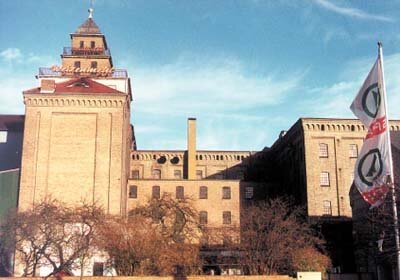 |
The vacant roller mill is to be used as a cultural centre (Source: plankontor GmbH, Hamburg) |
The local action plan, which has been developed for Neustadt since the autumn of 2001 thanks to the programme "Local Action Plans for Tolerance and Democracy," offers local youth and young adults opportunities to become involved in the design and development of their district. At the same time, the plan is a networking programme, because it requires close coordination of current and planned activities among actors and authorities. A network office has been set up for cooperation purposes by the Department of Youth, Social Affairs, and Health. Projects planned by associations, citizens' groups, and individuals operating in the district that have been unable to advance for lack of resources, are now supported by the local action plan budget, new projects have been launched, and new impetus generated. Projects and activities backed that focus on the interests of youth and young adults are given special priority.
- The aim of the "Neustadt Music Scene" project is to network a jazz band and a district band to promote the music scene in Neustadt. Young people from different ethnic backgrounds who are interested in music can make use of a complete set of musical equipment, and music gives them an opportunity to get to know and appreciate one another.
- "Neustadt: My Neighbourhood" is an adult education centre photography project that encourages young people, in particular, to take a close look at their district, the people who live there, and its history. The project opens up different (affectionate) perspectives of Neustadt, and is to be developed into a district gallery or culture workshop for youth and young adults.
- "Open Sport,"with the main emphasis on skating, supplements club sport in Neustadt within the context of the local action plan, and offers young people who don't (or don't wish to) join in club activities the opportunity to give vent to their energy, compete with one another, and engage in sport.
- An "Intercultural Bazaar" that already exists is in keeping with the intention of the local action plan to bring together people from different backgrounds and ethnic groups. The bazaar continues to take place annually, and now draws young people as staff, entertainers, and visitors.
- The "Space Exchange" is intended to network everyone looking for and offering space, for example for Neustadt local action plan projects. It is a central project module, since the implementation of many projects depends on the availability of premises in the sense of exhibition, rehearsal, or meeting facilities.
The "Guardian Angels" project operated by the Kindergarten Adelby GmbH is a participatory project to support parents and children through early support measures. The work of the Guardian Angels sponsoring association is based on the networking of institutions and people in the district, and is being supported for two years as a pilot project by the Schleswig-Holstein Youth Ministry. The Guardian Angels aim to prevent damage and disabilities in children by providing timely help. This is to be achieved by means of various modules:
- A family midwife, attached to the local hospital provides young families in Neustadt with assistance during pregnancy and in the postnatal period that goes far beyond the aid financed by health insurance. The midwife also offers preventive early care.
- A home care aid helps young families in collaboration with the parish of St. Peters in coping with everyday problems.
- A parents' centre, converted and made available by the Flensburg Workers Building Association, gives parents a forum where they can discuss major and minor problems with one another, where they can find and give tips for coping with everyday life, on health and educational problems, or where they can simply have a good chat.
 |
"Play area investigators" underway in Neustadt (Source: Sylvia Schröder, Flensburg-Neustadt district management) |
In the project "Play Area Analysis," children and adolescents have been underway in Neustadt as "play area investigators," inspecting their residential area with the help of Flensburg municipal youth welfare promotion to discover what possibilities public spaces offer for activities and play. The "play area investigators" sought the assistance of clubs, institutions, and interested groups. The projects proposed included play niches, play corners, playgrounds, play streets, and play paths, a play parking area that could be used part-time as a playground and exercise area, a school playground, play lots - vacant lots and other derelict land - which could be used temporarily for recreational activities, and non-earmarked, natural play areas, play meadows, play woods, play water, and play beaches, as well as sports areas and special youth areas. The proposals are looked into individually and coordinated with the integrated plan of action. A first project was inaugurated on 26 November 2001: the Mechelsenstraße playground, long abandoned, was redesigned by children and adolescents at a workshop under the guidance of a planner. Eighteen children between the ages of seven and twelve who live in the vicinity of the playground were able to put their ideas into effect. During the intensive work phase in the workshop, the children were not only able to contribute their own ideas, they also saw what fun it is to work together on a project. In the workshop they demonstrated their social competence and (perhaps?) made new friends.
5. Organisation and Management 
Since the beginning of the preparatory studies in 1998, the urban renewal process in Neustadt has been accompanied within the administration by the inter-departmental Neustadt working party, which meets monthly. This body discusses substantive demands for social urban renewal, the framework urban planning and other specific issues (e.g. play area analysis), as well as all relevant individual projects. Regular reports are presented on the work of the District Bureau.
In the second half of 2001, after first experience had been gathered with the Socially Integrative City programme, and after intensive discussion on the interim report presented by the local programme support team, it was decided that the two Environment and Planning and Youth, Social Affairs and Health Departments would have joint and equal responsibility for the model project "Socially Integrative City/Flensburg-Neustadt," represented by the director of the urban renewal division and a staff unit for the coordination of social planning. Joint control involves heading the Neustadt working party, financial planning for the model area, including resource bundling and programme coordination, as well as external representation of the overall undertaking and district management task coordination.
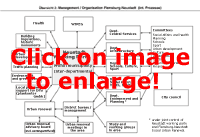 |
Neustadt working group (Source: plankontor GmbH, Hamburg) |
Members of the Neustadt working party include, beside the management, experts from the Environment and Planning Department, a representative of the health section of the Social Affairs, Youth, and Health Department, the district management, a representative of the business promotion company (WIREG), and a representative from each of the remaining departments. Depending on the matter in hand, other experts or actors from Neustadt are invited to attend.
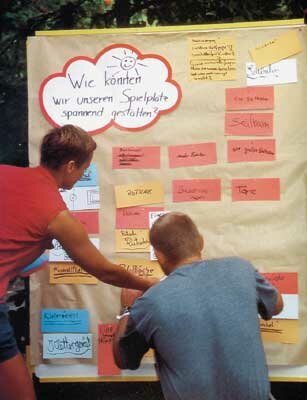 |
Replanning the Michelsenstraße playground at a workshop with children and adolescents (Source: Sylvia Schröder, Flensburg-Neustadt district management) |
As far as control of individual projects is concerned, projects are generally carried out under departmental responsibility in cooperation with the relevant municipal partners, but they are discussed by the Neustadt working party and the urban renewal meeting. Particular stress is placed on projects that combine constructional rehabilitation and social initiatives, like the youth project house. Those in charge of the project and the district management are required to harmonise building planning, participation, and social interests at a new level of quality so that the desired positive effects on the overall renewal process of Neustadt can actually be achieved.
The district management with the District Bureau constitutes the interface between the population, landlords, business people, social actors, and associations, as well as the municipal authorities.
The district managers commissioned by the municipality see it as their job to inform the population about social development of the district, to collect opinions, ideas, and wishes, and to forward them to, among others, the Neustadt working party, to take up initiatives for the further development of the district and to accompany planned projects until completion in coordination with the parties involved by mediating know-how, contacts, resources, and funds.
6. |
Activation, Participation, and Public Relations
|
District resident and actor activation and participation are initiated and promoted largely by social actors operating or established in the area, by the Flensburg Environment and Planning Department and Social Affairs, Youth, and Health Department, as well as the district management. Activation and participation takes place at both the informal and formal levels.
At the informal level, confidence has been won and contacts made since implementation of the "Socially Integrative City" programme began, so that people have committed themselves within the framework of the programme. For example, the district management attended the new year's reception at a local mosque, which led to the establishment of an interreligious study group and a discussion group of Muslim and Protestant Christian women to address everyday questions of living together in the community and religious issues. District festivals, recreation and fun days and other activities have helped to give socially deprived people, in particular, opportunities to share in the life of society and to obtain information about the Socially Integrative City in a casual setting.
The centrally located District Bureau has become a much frequented contact point for all citizens in the context of socially integrative district development. The bureau provides information about current projects and development, informal discussions take place, and individual advice is given. Residents can put forward their ideas about the neighbourhood, contact can be established between citizens, groups, clubs, associations, and action groups, and information on social and cultural services and events can be obtained.
Besides this informal activation and participation, the district management, which has its seat in the District Bureau, has initiated a number of district-wide, issue-specific working groups: the social working group, the Islamic-Protestant discussion group, the Turkish-German women's group, the housing and residential environment working group, the business working group. These groups are linked with the municipal Neustadt working party via the district management. The Neustadt working party conveys the interests, ideas, and project proposals of the working groups in the district to the urban renewal advisory board and the municipal policy committees.
Besides the working groups initiated by the district management, local institutions had joined forces even before the advent of the Socially Integrative City programme in the Flensburg-North working group (AKFN) to tackle the urgent social and economic issues and problems facing the area. Here, too, projects are discussed that help to give impetus to social life and participation in Neustadt.
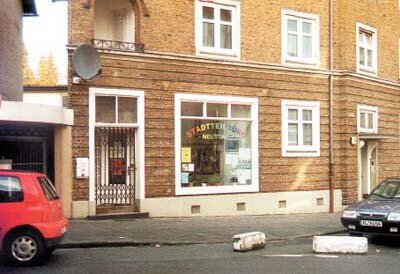 |
The centrally located District Bureau: contact point for the district population (Source: plankontor GmbH, Hamburg) |
Also before the start of socially integrative urban renewal, a group of business people had set up an association to promote their interests, the IG Neustadt. It is committed to improving the business and employment situation in the district.
Every three months the so-called urban renewal meeting takes place. It address the entire population of Neustadt. It is chaired by a member of the council resident in Neustadt. Invitations go out in three languages, Turkish, Greek, and German. The meeting is informative in nature. No decisions are made but opinions are sounded out, to be forwarded via the municipal Neustadt working party to the municipal policy committees. The relatively high levels of attendance (sometimes up to 150) shows the interest in and hopes for a positive development of the area.
The contingent fund, initially DM 15,000 for the model area, also has an activating and participatory function. The allocation of the funds is decided by the three Neustadt representatives (from IG Neustadt, Flensburg-North working party, tenants forum) in the citywide urban renewal advisory board.
Activation and participation are accompanied by public relations work like press releases, flyers, circulars, posters, and the Neustadt News, a magazine by and for young people from the district. In mid-2002 a district brochure is to brought out providing information on framework planning, the outlines of the integrated plan of action, on the first measures taken, and on opportunities for participation. Regular updates of this brochure are planned.
7. Conclusion: Things are Moving! 
Under the motto "Flensburg-Neustadt - Things Are Moving!", which accompanies all events taking place in the district, the socially integrative regeneration of Neustadt is well on its way. The bundling of the classical rehabilitation programme with the Socially Integrative City programme gives important impetus to the mixed-use, late nineteenth-century urban district with its specific resources and opportunities, and has an innovative impact in many fields. The local coordination and networking structures as well as horizontal and vertical communication and decision-making paths - and, not least of all, joint control by the Planning/Building and Social/Youth/Health Departments - are positive factors in efforts to achieve integrated and social-oriented development in the district.
This is apparent and tangible at the project level, too. The remodelling of the northern part of Neustadt, the conversion of the roller mill into a culture and media services centre and of the former logopaedic primary school into a youth project house, the Guardian Angels project, and the outcome of the play area study and the local action plan have meant that Neustadt is now being talked about in a positive vein. The housing industry is discovering Neustadt as a place to invest in. There is demand for commercial, catering, and services space, which will have a stabilising and structuring impact. There is sufficient potential for social and community projects, which are already contributing to improving Neustadt's image. The District Bureau has developed into a communication hub in the district.
At the moment, most funds are tied up in expensive, classical investment in rehabilitation projects like road construction, land acquisition, and building conversion. This is the necessary point of departure for urban renewal. But through the local action plan and through the initiative of working groups concerned with the district, the need has developed to secure the funding of community-oriented, communicative projects and ideas, and sustainable projects in keeping with the objectives of the Socially Integrative City programme. The bundling of resources means not only linking up money flows from various programmes but also contributing staff working-time and know-how, voluntary work and commitment. To stabilise this process, intensive discussions must be conducted between all the parties involved (also, for example, with the Schleswig-Holstein government and the employment office). Interdisciplinary project approaches must be precisely formulated, and existing programmes or support guidelines need to be adapted and sometimes reinterpreted.
For Neustadt most of the projects addressed will come to bear in 2002/2003. It is also planned in the short term to tackle the theme of "Living in Neustadt" in greater depth. But it must be said that, in spite of all the efforts that have been made, the process of integrative urban renewal has only just begun in the district, and only the very first fruits are to be seen. The parties involved have learned to cooperate, and see their work confirmed by the first successes achieved.
Im Auftrag des BMVBS vertreten durch das BBR. Zuletzt geändert am 25.05.2005